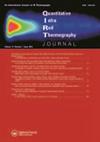热无损评价双域数据处理算法研究
IF 4.9
3区 工程技术
Q1 INSTRUMENTS & INSTRUMENTATION
引用次数: 6
摘要
本文介绍了主动热成像检测材料缺陷的数据处理算法的研究结果。该算法允许在时间和图像域对热成像序列进行分析。在算法运行的第一阶段,使用数学形态学或滤波对比度方法从样本中去除不均匀的加热,并使用局部和全局阈值方法对缺陷进行分割和检测。在下一阶段,可以确定缺陷的数量,并自动估计它们的深度和与背景材料(无缺陷的材料)相关的特性(绝缘体/导体)。在PMMA和Expanded PVC两种材料样品上对该算法进行了加热和冷却两个阶段的测试。研究发现,当处理来自冷却阶段的热成像数据并结合Top Hat形态学转换、局部阈值(用于缺陷检测)和相对增量过滤对比度(用于缺陷尺寸估计)时,可以获得最佳的缺陷检测和表征结果。本文章由计算机程序翻译,如有差异,请以英文原文为准。
Investigation on dual-domain data processing algorithm used in thermal non-destructive evaluation
ABSTRACT The paper presents the results of research on the data processing algorithm used to detect material defects using active thermography. The algorithm allows the analysis of thermogram sequences in both time and image domain. In the first stage of the algorithm operation, mathematical morphology or filtered contrast methods are used to remove the uneven heating from the sample, as well as to segment and detect defects using local and global thresholding methods. In the next stage, it is possible to determine the number of defects as well as automatically estimate their depth and characteristics (insulator/conductor) in relation to the background material (material without defect). The presented algorithm was tested on two material samples, i.e. PMMA and Expanded PVC, for two phases of the thermal process, i.e. heating and cooling. The study found that the best defect detection and characterisation results are obtained when processing thermographic data from the cooling phase in combination with a Top Hat morphological transformation, local thresholding (for defect detection), and relative incremental filtered contrast (for defect size estimation).
求助全文
通过发布文献求助,成功后即可免费获取论文全文。
去求助
来源期刊

Quantitative Infrared Thermography Journal
Physics and Astronomy-Instrumentation
CiteScore
6.80
自引率
12.00%
发文量
17
审稿时长
>12 weeks
期刊介绍:
The Quantitative InfraRed Thermography Journal (QIRT) provides a forum for industry and academia to discuss the latest developments of instrumentation, theoretical and experimental practices, data reduction, and image processing related to infrared thermography.
 求助内容:
求助内容: 应助结果提醒方式:
应助结果提醒方式:


